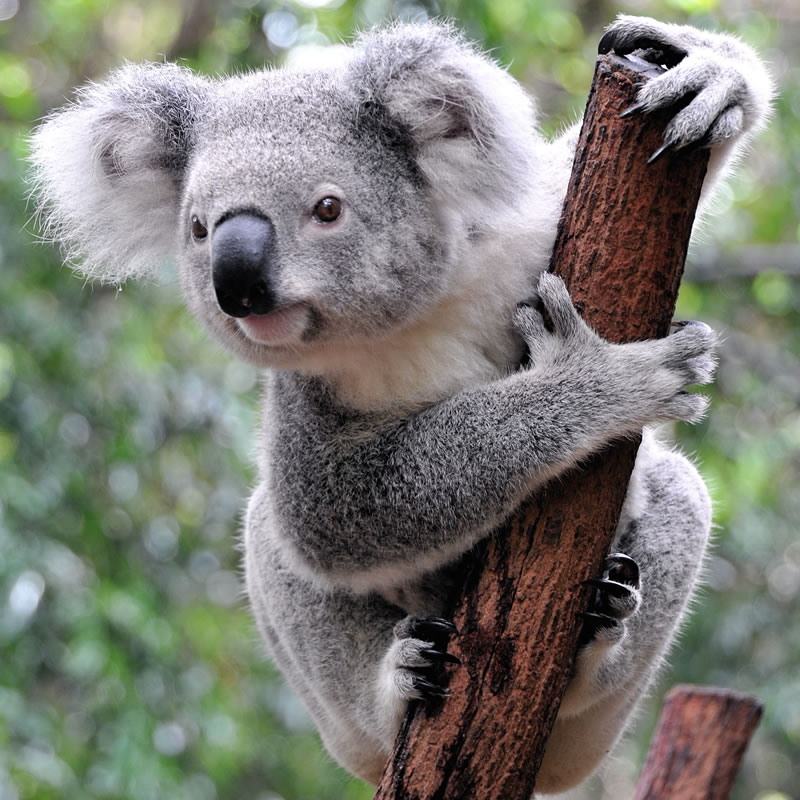
Scientific Name
Phascolarctos cinereus
Classification
| Kingdom | Animalia |
| Phylum | Chordata |
| Class | Mammalia |
| Order | Diprotodontia |
| Family | Phascolarctidae |
| Genus | Phascolarctos |
| Species | cinereus |
IUCN Redlist Status

Location
Koalas are found in Australia, in the areas of Queensland, Victoria, New South Wales, and South Australia.
Habitat
Koalas spend most of their time in trees. They live in eucalyptus forests which provide the vegetation they need to survive. Stable populations are typically only found in areas where their favorite types of trees are located.
Diet
These furry marsupials are herbivores with a unique diet that consists almost entirely of eucalyptus leaves. They are very picky eaters and will only dine on the leaves of certain tree species. They do occasionally eat leaves other than eucalyptus, such as tea tree leaves. Koalas rarely drink water, as they get most of the moisture they need from their diet. They usually only drink when they are sick or if drought conditions require them to take in more water than usual.
What is a marsupial? Marsupials are mammals that have pouches in which they carry and nurse their very young babies. Read on to find out more!
Size
Koalas weigh between about 5 and 25 pounds. Males are up to twice as large as females, and those found in the colder, southern climates are typically larger than in the north.
Description
Their soft fur is typically a silver-gray color, but it can also contain brown or tan areas. In the colder climates, cinnamon-colored fur is more common than in the north. Their chest and belly areas are usually white. Koalas have large, rounded, furry ears and a large black nose.
Reproduction
Like kangaroos, koalas are marsupials which carry their young in a pouch until they are mature. Koalas give birth to one joey at a time, which is usually about the size of a jellybean or smaller at birth. The joey then makes its way into its mother's pouch, where it nurses until it is about six months old. At around seven months of age the joey will no longer fit into its mother's pouch and begins to ride around on her back and eat leaves. A joey will often stay with its mother for another six to twelve months, or until the next joey is ready to leave the pouch and take its place on the mother's back.
Females reach reproductive age at about 5 to 6 years. They have a gestation or pregnancy period of around 230 days or 8 months. They give birth to one young at a time; in the rare case that twins are born, the mother will only care for one of them and the other is abandoned. Females will leave the bloat for a short time to go and give birth in seclusion.
Adaptations
Koalas have a very slow metabolism that allows them to survive on their nutrient-poor diet. Their food travels very slowly through their digestive system so that they are able to get as much nutrition from it as possible. They spend approximately 18-20 hours of each day sleeping or resting. They are most active at night, when the lower temperatures make it possible for them to conserve more water and energy during their daily activities. Their excellent sense of smell helps them differentiate between different types of leaves to help them decide which ones are edible.
Koalas are well suited for their life in the trees. They have two opposable "fingers" on their front paws, which allow them to easily grasp tree branches. This, in addition to their excellent sense of balance and long, strong arms, makes them expert climbers. Their heavy coat helps protect them from both hot and cold weather as well as helping to keep them dry in the rain. Koalas in the southern areas of Australia have adapted to the colder temperatures with thicker, heavier fur and they are larger than koalas from warmer regions.
Special Facts
There is much debate over the endangered status of the koala. Their primary threat is habitat loss, and although some areas of koala habitat are actually overpopulated, the areas that they are able to live in are shrinking. There are steps being taken to conserve the remaining eucalyptus forest land to protect the koalas from further population loss.
